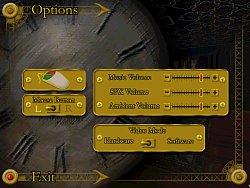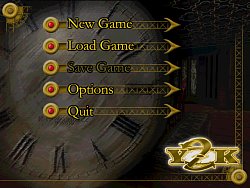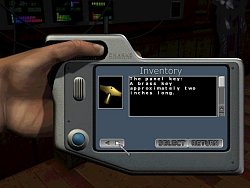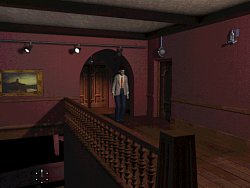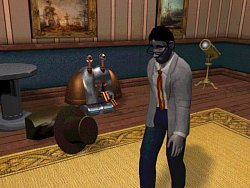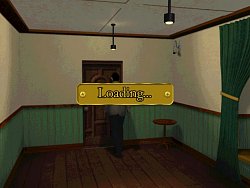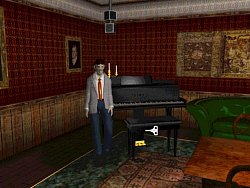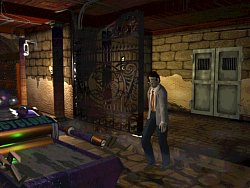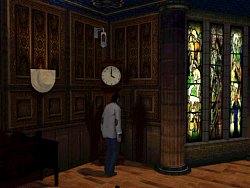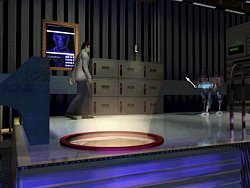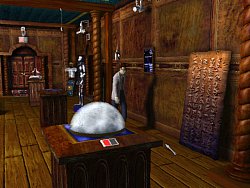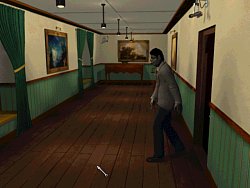![]() Diese Seite auf deutsch
Diese Seite auf deutsch
Back to Adventure-Archiv starting page
Y2K - The Game
by Runecraft (Developer)
Interplay (Publisher)
A review by slydos, 09th April 2001
| Story Dharke Manor is a house, that was originally built in the year 1876 and in the 20's of the 19th century was partially reconstructed by Aleister Dharke, an eccentric businessman and author of suspense stories. After his death, Dharke's electronics company used the house for extrication and experiments and much was changed and added. As the age of the micro-chip began, the efforts of Dharke Electronics concentrated on the development of advanced robots and artificial intelligence. So Dharke's house became the test area for these new developments and finally a fully computerized house with robot servants, automatic garbage disposal and control of all mechanisms. In the 90's the company decided to sell the house, since many of the secret projects did not run as required, and there was more annoyance than assumed with the artificial intelligence. Naturally the attorneys of Dharke Elelctronics prepared a waterproof contract to avoid compensation titles from the new owner. Exactly at this time it happened that Buster Everman, an inconspicuous employee of the company, won a large prize in a lottery and wanted to carry out his dream of a big house.
Buster didn't want to wait, until he could move in properly, but started immediately after the purchase to occupy the house and that just on New Year's Eve of the year 1999 without the smallest notion that hardly one of the systems in the house was year-2000-compatible. The only person, however, paying still some attention to those things is Candace, a programmer of Dharke Electronics and also Buster's girl friend. She succeeded in programming an upgrade for the main computer. On New Year's Eve she is on her way to Dharke Manor to install the software... Here the game begins: Candace finds a rather drunk Buster - and the pointers of the clocks are nearing twelve. Buster awakes on his bed and must notice that he can't move any longer freely in the house - the robots and computers have taken over the command. In addition Candace has disappeared ... Buster on his very own now must outwit the computers and find Candace. |
Beginning
However this story can't be found on the game's retail box, but in a quite hidden file on the second game CD. "Y2K" comes in the normal retail box with 2 CDs and a short technical guide in English and French. Here you can find help with the installation and also to some hotkeys - however the gamer doensn't get much information about the How To's, What's and Why's of this game. During the installation process you are informed that the manual can be found as file on the second CD. "Well, I don't I need it, nowadays most games run usually very intuitive." - I thought. Thus I first made the minimum installation of 100 MB (400 MB would be the complete installation) and adjusted the hardware mode in the game options. After that we are ready to start and can see Buster in 3d and 3rd-person-perspective awaking on his bed. But after he said some text, an arrow cursor appears on the screen, which does not change and also leads nowhere. So I had to leave the game again (with F2 - this is indicated in the technical reference) and took a closer look at the manual on CD2. Aha, here one is informed that one must click the right mouse button and keep it pressed, in order to change your viewing angle on the scene. So you can freely move around to detect hotspots. A clock cursor shows that Buster can move to a certain place. A key-cursor displays that there is an object, with which you may interact or simply can get a brief textline about it. If you click with the left mouse button on such an object, quite often - however not always - a small context menu appears, from which you then again can select an action such as "examine" or "pick up" etc. by mouse-click. It would have been easy to have indicated these information also in the written guidance - there are 7 interaction verbs and 6 keyboard hotkeys for the controls. Thus already was the first puzzle: Find the information about the game controls! Buster has also an inventory in form of a PDA ( I think "personal data assistant" is the translation for these useful small items, which are used sometimes in games as communication interface or like here as inventory). You can call the PDA with the spacebar then select with the mouse either the inventory or the descriptions of the individual rooms of the house. The 14 rooms are each represented by a small picture and you get information about their names and what they are serving for. Inventory objects are also represented by small pictures with an additional text description and you can scroll through them with small arrow keys below. If you want to use an inventory object later with another object, you must click on the "select-key" in the PDA. One cannot combine inventory objects with each other. If you find an area or an object in the house, with which you want to use an inventory item, you have to proceed this way: Open PDA with spacebar, select inventory, scroll through inventory until item is found, select item with "select-key" (PDA then closes automatically), click on object on the screen with left mouse button, in the context menu select "use selected item" and within a short time you've executed the action - wasn't that fast? Bad of course, if the object did not fit and you have to repeat the whole thing. Besides it's important, that you absolutely always execute first the verb "examine" of the context menu, because it can be, that with a 2nd click on the object, further verbs appear in the context menu. I must say, an extremely pedantic procedure and the changes between spacebar and then again mouse control could surely be solved in a different way. As frequent adventure gamers you are used to save your game often. But this luxury can't be found in the Y2K-game. If you press the F2-key, in order to access the save/load menu, you then can click on "Save Game" - but that's it - there is only one Savegame! Under F8 there is still another quick save function and this would have done in this case, they could have saved the extra menu. In the further process of the game the presence of only one save-slot turns out as fatal obstacle, which did not offer a possibility of terminating the game without restart. But more about this later. Controls You are not free to control Buster. You can change your own view in 360 degrees, both upwards and downwards, but Buster runs only to a few given spots and can't be moved neither an inch to the right or left (even most freeware games are somewhat friendlier to the gamer and let the leading actor run into all possible corners). And because Buster's movements are so reduced, it's sometimes very amusing that he does not take the shortest way from A to B, but runs in another direction first or moves zigzag. To use an object he has to go there most of the time - otherwise an interaction is not possible. Sometimes movements of the actually rigid Buster - who seems to be always weak in his knees - get a bit more relaxed, if during his movements the camera angle changes. But that is not always wanted by the player, because you can't execute an action on a certain object from a close-up anymore but suddenly must take aim on a far away object. Graphics The graphics are very good for a 3D-game and in hardware mode, which can be selected with installation or in the options menu, Buster and his environment are shown with good edge smoothing. The 14 rooms and prerendered backgrounds from Dharke Manor are designed with lots of details and a large number of clickable objects serve as decoration and also want to divert the gamer in a certain way on his quest. Each room has its own atmosphere by different styles and different music. Unfortunately our 3D-"hero" is not always complete - at some places like the corridor to the navigation room or in the cellar whole parts of him will be suppressed and he runs around as only half a man. Additionally the cursor doens't move correctly if on the screen several persons or objects are moving, by the way independently from hardware configuration. Then there are also difficulties with the selection of context menu options, which must be clicked on several times before release. Those are things, which one can endure more or less with some patience. However there was one - I want to call it game element - which was really annoying: With each walking into another room, with each change of the perspective a large golden "Loading"-sign appears for 3 to 5 seconds. That's interrupting the game and doesn't let you really dive into the story. It also looks kind of strange, when Buster uses an object from the inventory without moving an inch or gesticulating somehow. The object then appears at the intended place as if a ghost put it there. Puzzles/game process Buster must gain the access to each room and usually needs a set of objects for the solution, which must be applied at the correct spot (and also at the right time or in the correct sequence). There is also a musical puzzle - but it can be also solved with other aids. Some number combinations must be found out but there are always logical hints and the degree of difficulty isn't very high altogether. However there is a cliff, a bug, which is really killing fun: It is possible to solve the puzzles in different order and to enter also rooms in different order. Now if you enter a certain room too early, an action will be executed, which is necessary for the endgame, but couldn't be repeated later in the game. Therefore the game isn't solvable for the normal player at the end, who enters all rooms and examines everything first, since one cannot create a second savegame, as described above. Either you start the game from the beginning or use a savegame, that you can download from the walkthrough link, to be able to experience the end of the game. I can't understand, how such an amount of bugs and design errors could survive the two test teams, which are named in the credits! Perhaps it was because one if the testers was Mick Jagger or the end-bug was taken into account to force the player to replay the game. Or simply, because the play did concern the Millenium Bug and the developers didn't want to do things handsomely - who knows? In the credits you're warned: "Beware of the Bug!" As for the handling I have to add that, if you enter one of the two floors also one of the two CDs must be inserted each time and at the beginning of each game-session CD1 must be in your CD-drive. Despite the different handicaps such as loading screen, CD-changes etc. "Y2K" nevertheless can be played in approx. 10 to 12 hours. Therefore the normal price of 59,90 DM appears to me too high. Sound/speech The entire game and the documentation are in English. Since there are some important hints in conversations, - beside a great amount of patience - a good English knowledge should be a prerequisite for playing YK2. Who cannot be deterred and wants to assume the challenge, could listen to a team of professional actors. There are no dialogues, in which one can intervene, but either the comments of Buster or automatic conversations with the machines and robots or also with friend Candace. The quality of speech is excellent. I would say the humor of complacent anti-hero Buster seems a little bit forced in Larry-manners. But that is a pure matter of taste. In each of the 14 rooms there is another background music often quite different and usually it fits well and gives atmosphere. Also distinguished the sound effects, which enrich the different rooms and the ambiente likewise atmospherically. Particularly thrilling was the torture chamber, where a robot hangman followed its horrible task. General impression Altogether one can say that an actually good idea was given away by bad game design. Little gaming comfort (missing save slots, the handling of inventory and objects, constant waiting while the loading of a new screen, partial incorrect character graphics) suggests that the developers could not carry out a lot of features by the time pressure of the approaching Millenium date and delivered only an incorrect product. The strange, sometimes unnecessary movements and steps of Buster could be interpreted on the fact that the game was actually planned more extensive. The missing game depth and lack of design don't let arise real suspense. Total rating 53%. Tip: A really thrilling short story about an automatic house is Ray Bradbury's "The Veldt" from "The Illustrated Man".
Adventure-Archiv-rating system:
Minimal system requirements:
Recommended configuration:
Played on:
|
|
Copyright © slydos for Adventure-Archiv, 09th April 2001
Back to Adventure-Archiv starting page

